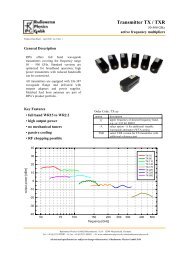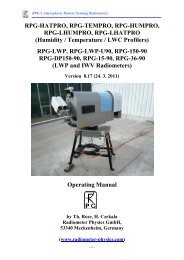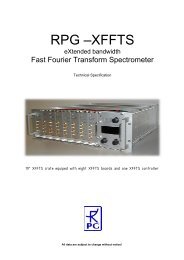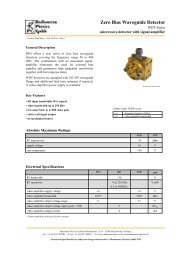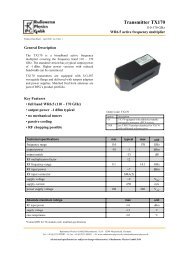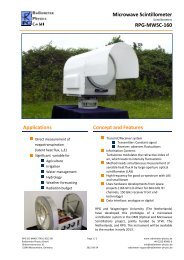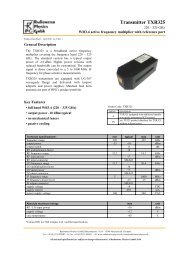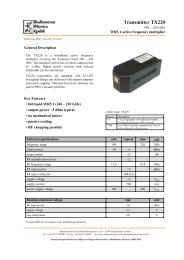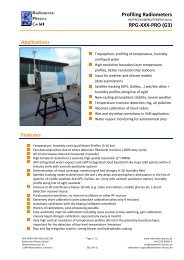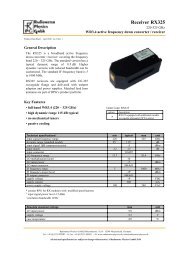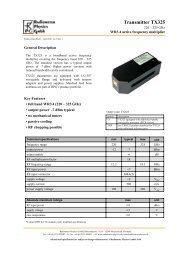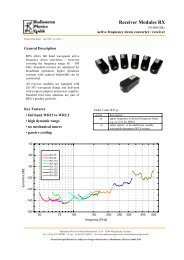on Dual-Polarization Radiometers - Radiometer Physics Gmbh
on Dual-Polarization Radiometers - Radiometer Physics Gmbh
on Dual-Polarization Radiometers - Radiometer Physics Gmbh
You also want an ePaper? Increase the reach of your titles
YUMPU automatically turns print PDFs into web optimized ePapers that Google loves.
<strong>Dual</strong> Polarized <strong><strong>Radiometer</strong>s</strong>DPR SeriesRPG‐DPR‐XXXIntroducti<strong>on</strong>The RPG‐XCH‐DP is a 2/3/4 frequency, dual polarisati<strong>on</strong> radiometer with direct detecti<strong>on</strong> receivers andcomplete auto‐calibrati<strong>on</strong> fr<strong>on</strong>tends. The system requires no external calibrati<strong>on</strong> targets and performs skytippings for absolute calibrati<strong>on</strong> purposes. The system is split into different frequency modules which aregrouped <strong>on</strong> top of a precisi<strong>on</strong> elevati<strong>on</strong> / azimuth positi<strong>on</strong>er. Therefore the antennas can reach every pointin the sky and complicated scanning schemes, including full sky LWP / IWV maps are possible.One of the key features is the measurement of polarisati<strong>on</strong> difference (PD) during rain events under e.g. 30°elevati<strong>on</strong> angle. Falling droplets are flattened due to the air resistance from below and nearly form anellipsoid with l<strong>on</strong>g axis al<strong>on</strong>g the horiz<strong>on</strong>tal directi<strong>on</strong>. Therefore the emissi<strong>on</strong> of falling droplets is morepr<strong>on</strong>ounced in the horiz<strong>on</strong>tal polarisati<strong>on</strong> compared to the vertical. This allows for the separati<strong>on</strong> of cloudliquid (perfectly round droplets, approx. 20 µm in diameter) and rain liquid. Without taking the polarisati<strong>on</strong>difference into account, a radiometer overestimates the total liquid water c<strong>on</strong>tent during rain by assumingthat the brightness temperature signal is all generated by small cloud droplets. The small cloud dropletsproduce a much lower sky temperature than the bigger rain droplets, even with the same amount of liquidwater. Therefore the rain droplet c<strong>on</strong>tributi<strong>on</strong> to the sky temperature is relatively large while theirc<strong>on</strong>tributi<strong>on</strong> to the total liquid is smaller.HighlightsZenith Sky Observati<strong>on</strong>sWhen observing the sky in zenith directi<strong>on</strong>, polarizati<strong>on</strong> splitting should be zero, even if clouds are passingthe field of view. Falling rain droplets are vertically flattened, but this cannot be seen in zenith directi<strong>on</strong>.36.5 GHz (H/V)18.7 GHz (H/V)Fig. 1 Brightness Temperature time series (two frequencies, dual polarizati<strong>on</strong>).RPG‐MWR‐DPR‐TN03‐2012‐09 Page 2 / 8 www.radiometer‐physics.de<strong>Radiometer</strong> <strong>Physics</strong> GmbH +49 2225‐99981‐0Birkenmaarstrasse 10info@radiometer‐physics.de53340 Meckenheim, Germany 2012‐09‐21 radiometer‐support@radiometer‐physics.de



